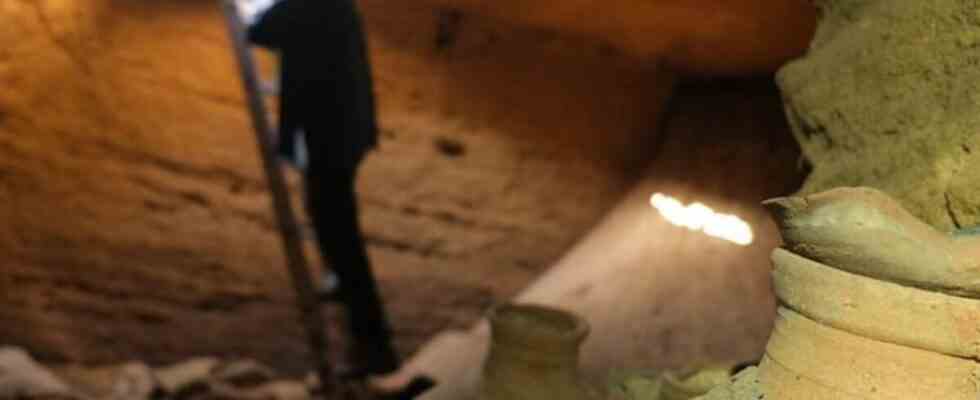Archäologen der israelischen Altertumsbehörde benutzten eine Leiter, um in die quadratische, von Menschenhand geschaffene Höhle zu gelangen, von der sie sagten, sie sei seit etwa 3.300 Jahren unberührt gewesen. Die Grabstätte enthielt Dutzende von Keramikgefäßen in verschiedenen Formen und Größen, berichtete das Team, zusammen mit einer Reihe von Bronzeartefakten. Unter den Artefakten befanden sich Schalen – einige rot bemalt, andere mit Knochen – sowie Kochtöpfe, Kelche, Lampen und Vorratstöpfe.
Zu den in der Höhle vergrabenen Grabbeigaben gehörten auch Waffen in Form von scheinbar bronzenen Pfeil- oder Speerspitzen.
Die Gegenstände wären in das Grab gelegt worden, um den verstorbenen Bewohner auf seinem Weg ins Jenseits zu begleiten, sagten die Archäologen.
Die Ecke der Höhle enthielt zwei rechteckige Parzellen, in denen die Experten mindestens ein relativ intaktes Skelett ausgegraben hatten.
Die Entdeckung wurde am Sonntag der Welt bekannt gegeben.
Der Experte für die Bronzezeit, Dr. Eli Yannai von der Israel Antiquities Authority, sagte: „Die Tatsache, dass die Höhle versiegelt und in späteren Perioden nicht geplündert wurde, wird es uns ermöglichen, moderne wissenschaftliche Methoden anzuwenden […[ to retrieve much information from the artefacts and from the residues extant on the vessels, for example, organic remains that are not visible to the naked eye.
“The cave may furnish a complete picture of the Late Bronze Age funerary customs.”
The fact that the cave had remained sealed until now, he added, was “extremely rare” and made it a “once-in-a-lifetime discovery”.
Dr Yannai said: “Burial caves are rare as it is, and finding one that hasn’t been touched since it was first used 3,300 years ago is something you rarely ever find.
“It feels like something out of an Indiana Jones movie — just going into the ground and everything is just laying there as it was initially.”
READ MORE: Remains of ‘vampire’ woman unearthed from 17th century grave in Poland
The archaeologists noted that the tomb dated back to the time of the Egyptian pharaoh Ramesses II, whose reign spanned from 1279–1213 BC.
He was one of the most celebrated pharaohs of ancient Egypt’s new Kingdom, known for his early focus on the construction of cities, monuments and temples — but also is associated with the Biblical Exodus from Egypt.
Dr Yannai said: “In this period, in the long reign of the Nineteenth Egyptian Dynasty Pharaoh Ramesses II, the Egyptian Empire controlled Canaan, and the Egyptian administration provided secure conditions for extensive international trade.”
Ramesses II died around the age of 90 and was buried in a tomb in the Valley of the Kings. His remains are presently on display at the National Museum of Egyptian Civilization in Cairo.

